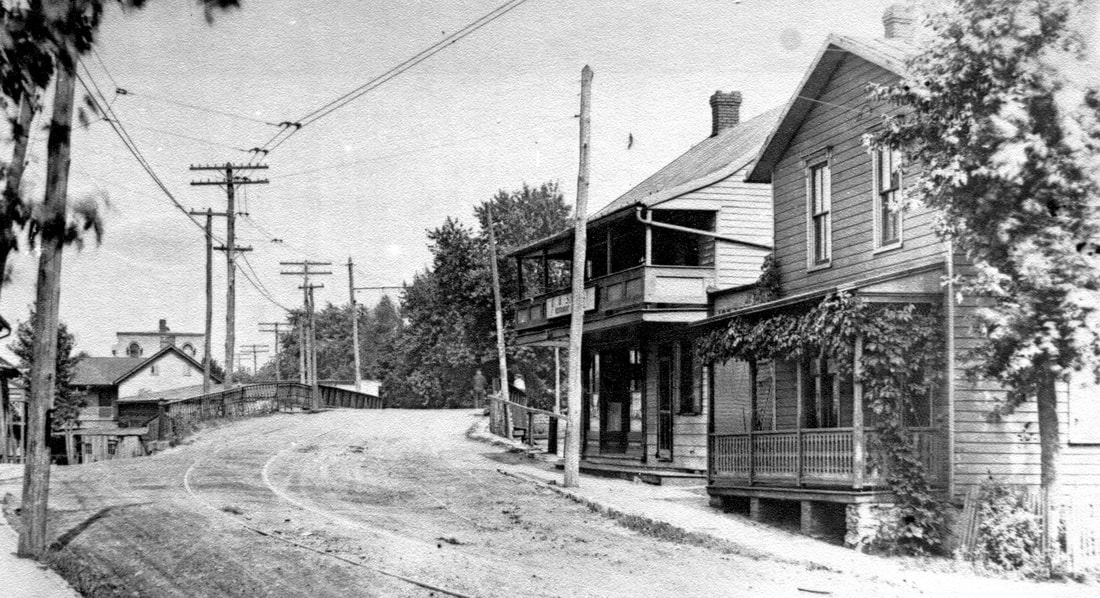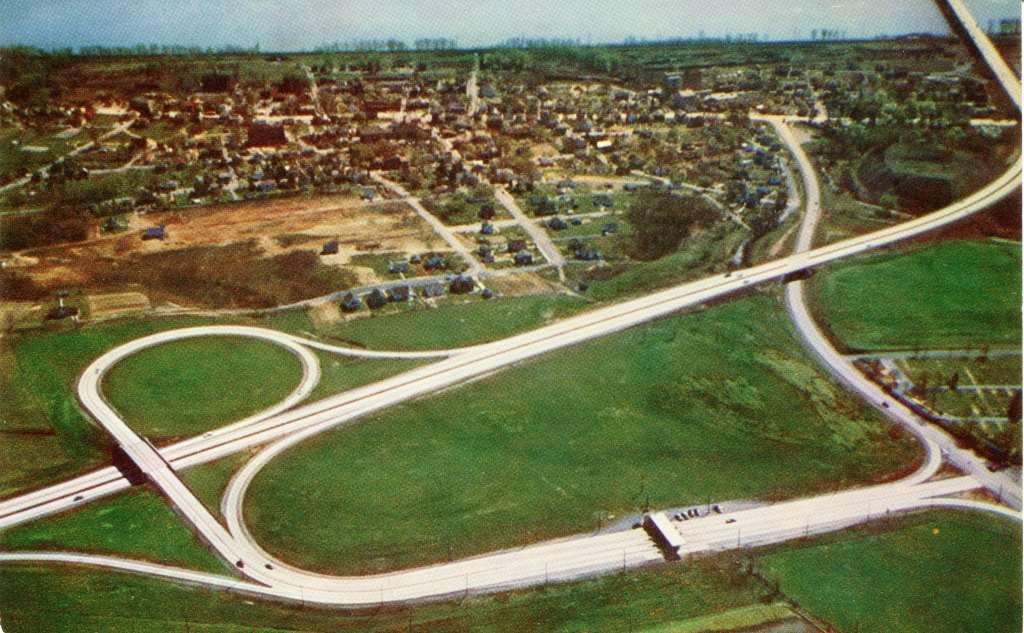Transportation
Highspire grew slowly during the first 30 or so years of its existence. However, major changes took place in the transportation routes through Highspire that would have profound influence on the town’s development. In 1832, the Pennsylvania Canal was completed through Highspire. It entered Highspire along the river on the west end, then curved away from the river and crossed Second Street in the center of town, cutting the village in half. The canal and the camelback bridge where Second Street crossed the canal would be prominent features of Highspire for the next 75 years.
Approaching the Pennsylvania Canal Bridge on Second Street heading west around the turn of the 20th Century. Shelly's Restaurant is is just east of the bridge on the right hand side in this photo.
In August 1836, the first section of the Harrisburg, Portsmouth, Mount Joy and Lancaster Railroad was completed from Middletown to Harrisburg. This railroad would later be absorbed into the Pennsylvania Railroad system. At first, small cars on the iron tracks were pulled by horses. In September 1836, an English John Bull locomotive was acquired for motive power. Gov. Joseph Ritner and other state officials rode from Harrisburg to Middletown for a grand opening celebration. The original tracks were laid along the path of the old freight tracks between Front and Water Streets. The north side of Water Street would be the main rail route between Harrisburg, Lancaster and Philadelphia for the next 68 years. Railroad construction, maintenance and operation were a major employer in Highspire in the later 19th century.
Highspire Station of the Pennsylvania Railroad late 19th Century. The station was located just west of Railroad Street on the north side of the tracks. The men in the photo are the track maintenance crew.
In 1891, a group of capitalists in Central Pennsylvania organized a company to extend the electric railroad (trolley) along the Middletown-Harrisburg Turnpike between Steelton and Middletown. The new line would start at Mohn Street in Steelton, the terminus of the East Harrisburg Passenger Railway. The first order of business was to fill and regrade the Middletown-Harrisburg Turnpike. A temporary track was laid to transport cinders from the steel works to fill the turnpike. As much as four feet of fill was required in places.
On Tuesday November 8, 1892, The Patriot reported, “The bridge at Highspire on the Middletown, Highspire and Steelton line is finished and cars are expected to run regularly to Middletown by next Saturday.” With the build-out of the trolley system for local transportation, and the railroad system for transportation between towns and cities, almost all passenger travel was by rail. This was one of the main reasons for the poor condition of the road system at the dawn of the 20th Century.
The rapid growth of automobile traffic after the turn of the century caused a decline in trolley traffic starting in 1924. In 1933, the Harrisburg Traction Company, later renamed Harrisburg Railways, decided to convert three of its trolley lines to buses. As ridership continued to decline, more buses were purchased and more trolley routes closed. The last Harrisburg Railways trolley was operated on the Middletown line on July 16th, 1939, 47 years after the introduction of electric powered trolley service in Highspire.
On Tuesday November 8, 1892, The Patriot reported, “The bridge at Highspire on the Middletown, Highspire and Steelton line is finished and cars are expected to run regularly to Middletown by next Saturday.” With the build-out of the trolley system for local transportation, and the railroad system for transportation between towns and cities, almost all passenger travel was by rail. This was one of the main reasons for the poor condition of the road system at the dawn of the 20th Century.
The rapid growth of automobile traffic after the turn of the century caused a decline in trolley traffic starting in 1924. In 1933, the Harrisburg Traction Company, later renamed Harrisburg Railways, decided to convert three of its trolley lines to buses. As ridership continued to decline, more buses were purchased and more trolley routes closed. The last Harrisburg Railways trolley was operated on the Middletown line on July 16th, 1939, 47 years after the introduction of electric powered trolley service in Highspire.
Trolley construction just west of the Pennsylvania Canal bridge 1892.
Residents along the Middletown-Harrisburg Turnpike complained regularly about its condition during the late 1800s. On March 16, 1903, a petition from residents of Steelton to condemn the Harrisburg-Middletown Turnpike was presented to the Dauphin County Court. Coincidentally, this was the same date the petition to incorporate Highspire as a borough was presented.
The court appointed “viewers” to inspect the turnpike to determine if it was being adequately maintained. They also heard testimony from the majority stockholder, Highspire resident George W. Cumbler, and residents of the communities serviced by the turnpike. The viewers reported in favor of condemning the turnpike and recommended awarding the turnpike company $6,320 in compensation. On January 27, 1904, the court approved the petition, and ownership and maintenance responsibility passed to the local communities.
The age of the automobile blossomed soon after the Middletown-Harrisburg Turnpike converted to public ownership. Just prior to that event, the Pennsylvania Highway Department was created on April 15, 1903. In 1911 the General Assembly set up an 8,835-mile system of roads to be maintained by the state Highway Department. The old turnpike, Second Street, became part of this state highway system.
In 1921, the Federal Aid Highway Act provided for up to 7 percent of nonurban state roads to be designated as “primary” roads and eligible for 50 percent federal assistance. From 1926 to 1967 the entire length of the current PA Route 230, including Second Street in Highspire, was designated as U.S. Route 230.
Until 1950, U.S. Route 230 through Highspire was the primary highway route between Philadelphia and Harrisburg. Because of the importance of this route and the resulting traffic, in 1945 the Legislature approved a plan to widen U.S. Route 230 to a three-lane road. Construction was completed in 1948 and 1949. The project required the removal of many trees, the narrowing of many sidewalks, and the demolition of a few old dwellings along Highspire’s Second Street. Many older residents believed this detracted from the charm of the Highspire they knew in the early 20th Century.
Even before the U.S. Route 230 widening was completed, construction commenced on the eastern extension of the Pennsylvania Turnpike between Carlisle and Valley Forge. This section of the turnpike opened on November 20, 1950, and from that time it became the primary route between Harrisburg and Philadelphia.
Turnpike construction had a significant impact on transportation into and out of Highspire. The highway ran along Highspire’s western border with Steelton and a large embankment was required there for the approach to the new bridge across the Susquehanna. More significantly, several roads leading out of west end of Highspire to the north were severed by the new turnpike. Before the turnpike, Paxton Street, Race Street and Vine Street all continued north out of town. Paxton Street met Race Street at the Highspire Cemetery. All three of these roads were replace by a realigned PA LR 22019, known today as Eisenhower Boulevard, from U.S. Route 230 to Derry Street. This new “bypass” provided the entrance and exit to the new Harrisburg East Turnpike Interchange bordering Highspire to the north.
The court appointed “viewers” to inspect the turnpike to determine if it was being adequately maintained. They also heard testimony from the majority stockholder, Highspire resident George W. Cumbler, and residents of the communities serviced by the turnpike. The viewers reported in favor of condemning the turnpike and recommended awarding the turnpike company $6,320 in compensation. On January 27, 1904, the court approved the petition, and ownership and maintenance responsibility passed to the local communities.
The age of the automobile blossomed soon after the Middletown-Harrisburg Turnpike converted to public ownership. Just prior to that event, the Pennsylvania Highway Department was created on April 15, 1903. In 1911 the General Assembly set up an 8,835-mile system of roads to be maintained by the state Highway Department. The old turnpike, Second Street, became part of this state highway system.
In 1921, the Federal Aid Highway Act provided for up to 7 percent of nonurban state roads to be designated as “primary” roads and eligible for 50 percent federal assistance. From 1926 to 1967 the entire length of the current PA Route 230, including Second Street in Highspire, was designated as U.S. Route 230.
Until 1950, U.S. Route 230 through Highspire was the primary highway route between Philadelphia and Harrisburg. Because of the importance of this route and the resulting traffic, in 1945 the Legislature approved a plan to widen U.S. Route 230 to a three-lane road. Construction was completed in 1948 and 1949. The project required the removal of many trees, the narrowing of many sidewalks, and the demolition of a few old dwellings along Highspire’s Second Street. Many older residents believed this detracted from the charm of the Highspire they knew in the early 20th Century.
Even before the U.S. Route 230 widening was completed, construction commenced on the eastern extension of the Pennsylvania Turnpike between Carlisle and Valley Forge. This section of the turnpike opened on November 20, 1950, and from that time it became the primary route between Harrisburg and Philadelphia.
Turnpike construction had a significant impact on transportation into and out of Highspire. The highway ran along Highspire’s western border with Steelton and a large embankment was required there for the approach to the new bridge across the Susquehanna. More significantly, several roads leading out of west end of Highspire to the north were severed by the new turnpike. Before the turnpike, Paxton Street, Race Street and Vine Street all continued north out of town. Paxton Street met Race Street at the Highspire Cemetery. All three of these roads were replace by a realigned PA LR 22019, known today as Eisenhower Boulevard, from U.S. Route 230 to Derry Street. This new “bypass” provided the entrance and exit to the new Harrisburg East Turnpike Interchange bordering Highspire to the north.
Pennsylvania Turnpike interchange at Highspire 1950. Rt. 230 runs left to right through Highspire at the top of the photo. The interchange connects with the new Eisenhower Boulevard at the lower right.
In 1967, Pennsylvania Route 283, a 29-mile limited-access freeway, was completed from Eisenhower Boulevard to U.S. Route 30 in Lancaster. It intersects Interstate 283 and the realigned turnpike interchange at Exit 1, just north of Highspire. This road parallels Route 230, and upon its completion most of the remaining long-distance traffic through Highspire was diverted to the new freeway. At that time, Route 230 was downgraded from a U.S. to a state route, and today it accommodates mostly local traffic.



